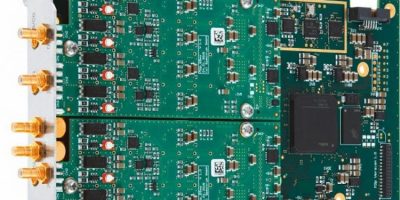Arbitrary waveform generators fulfil ultrasound and lidar requirements
Six arbitrary waveform generator cards from Spectrum Instrumentation are optimised for signal quality, size and cost, says the company. The 65 series AWGs offer 16-bit DACs, a fast PCIe x4 interface with up to 700Mbytes per second streaming speed and a card length of only 168mm to fit into nearly every PC. With 40 or 125Msamples per second speed, a large on-board memory of 512Msamples, output levels of up to ±6.0V and four additional multi-purpose outputs. The cards are designed for frequencies between 1.0 and 60MHz in ultrasound, laser, lidar, radar, automotive, medical science and big physics experiments.
Users can select from two separate output speed rates of 40 or 125Msamples per second and models that have one, two or four channels per card. Each channel features its own DAC and output stage. Multi-channel cards share a common clock and trigger to ensure full synchronisation and the output stages incorporate four switchable filter paths to help optimise signal quality. At the same time, they can produce output swings up to ±6.0V into a high impedance (1MOhm) load or ±3.0V into 50Ohms. The flexible output stages combine with the high resolution 16-bit DACs to enable the generation of signals with very low distortion, dynamic range and a high signal-to-noise ratio (SNR).
To allow the M2p.65xx series AWGs to generate long and complex waveforms, each card also comes equipped with a generous 512Msamples of on-board memory. The large memory is complemented by a variety of different output modes. For example, the memory can be segmented and waveforms can be created by looping on, and switching between, different segments. The cards also feature a FIFO streaming capability that enables new waveform data to be read over the fast PCIe bus (at up to 700Mbytes per second) while replaying already transferred information. This allows users to create long, single shot waveforms or constantly changing, burst-type signals such as those found in radar, ultrasound, lidar or sonar systems.
For applications that require the connection of AWGs and digitisers, such as stimulus-response or closed-loop applications, Spectrum’s Star-Hub piggy-back module synchronises up to 16 M2p class products. For example, the M2p.65xx AWGs match the M2p.59xx 16-bit digitisers released last year. The M2p.59xx digitisers offer one to eight channels with sampling rates between 20 and 125Msamples per second. The Star-Hub distributes a common clock and trigger signal to each channel ensuring fully synchronous operation. Star-Hub systems can also be used where multiple test points, or arrays of sensors, need to be stimulated by different test signals at the same time.
To control and generate signals, the cards are programmable and drivers are provided, free of charge, to support the most popular languages (such as C++, VB.NET, C#, J#, Delphi, Java or Python code) as well as third party software tools like LabView and MatLab.
Alternatively, users can simply run Spectrum’s own software, SBench 6 Professional. This tool 6 enables the user to control all the modes and settings of the AWG via a simple interface. The software is designed to support multi-channel operation and has a host of built-in features for waveform display, signal generation, data analysis and documentation. Basic signals can be created using the software’s EasyGenerator function that produces waveforms like sine waves, triangles or rectangles with programmable frequency, amplitude and phase. More complex signals can be created using mathematical equations or imported from other programs or devices (such as digitisers or oscilloscopes) using Binary, ASCII, or Wave formats.
Once installed in a PC, the AWG cards can integrate with other test and measurement devices. The signal outputs as well as clock and trigger inputs are provided via front-panel SMB connectors. The front panel also hosts four MMCX connectors (one multi-function output, and three multi-function I/O lines), which can be used for tasks such as digital output channels, clock, trigger or status output as well as asynchronous I/O lines.
Switching the multi-purpose I/O lines to digital output adds another four synchronous output channels to the AWG. A single AWG card can then generate four analogue outputs and four digital outputs in parallel with full speed to interface with external equipment in experiment control or for OEM projects.
The Spectrum M2p.65xx series AWGs are in full production and available for immediate delivery. All cards are shipped factory tested and include a base version of Spectrum’s SBench 6 software for first tests. Software and firmware updates are free of charge for the lifetime of the product. Support is via an in-house team of engineers.




